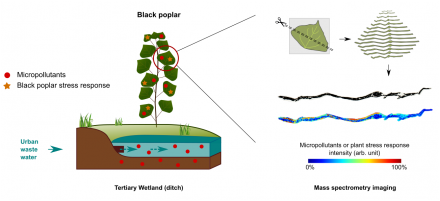In a study focused on water quality at the exit of a wastewater treatment facility, researchers from Plant Imaging & Mass Spectrometry platform could observe the diffusion of some micopollutants in water and sludge, but also black poplar (Populus nigra) leaves. Mass spectrometry imaging allowed the visualization of micropollutants accumulated in leaf tissues, and the associated plant response. This study was published in the journal Environment International in March 2019.
The Plant Imaging & Mass Spectrometry platform was recently equipped with an instrument allowing in situ analysis of molecules in biological samples: the SolariX. This instrument was used for an environmental study to investigate the metabolic profile of a black poplar (Populus nigra), which was planted at the exit of a wastewater treatment facility. This poplar grows in an area called tertiary wetland, in which the water runs before going back to the environment in a stream.

Legend :Urban wastewater, even after treatment, is a vector of pollutants (red dots) which are diffusing in the environment (soil, living organisms). These pollutants, as well as stress markers associated with their accumulation (orange stars), could be identified and spatially localized in leaf tissues using mass spectrometry imaging.
The study shows that micropollutants are still detectable in the output water from the treatment facility, and are diffusing in sludge and poplar. A closer look to poplar leaves using the SolariX allowed the identification and spatial localization of micropollutants in leaf tissues, but also plant metabolites. Thus, thus study revealed that micropollutants carried by the water are specifically accumulated in black poplar leaf tissues. This accumulation induces a stress response from the plant, which adapts its metabolism.














